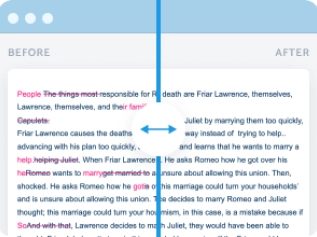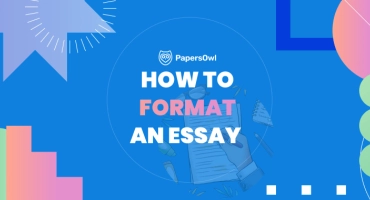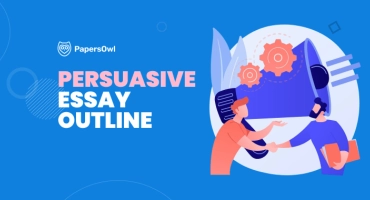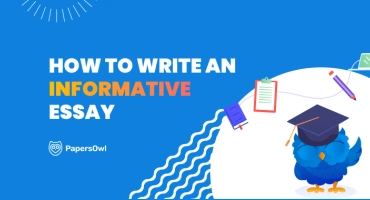3 Paragraph Essay: Clarity in Brevity
Table of contents
- 1 Understanding the Three-Paragraph Essay
- 2 Break Down the Three-Paragraph Essay Structure
- 3 Pre-Writing and Planning
- 3.1 Tips for Selecting a Suitable Topic for a Concise Essay
- 3.2 Outlining
- 3.3 Crafting a Concise Thesis Statement that Guides Your Essay
- 3.4 Crafting a Strong Hook to Engage the Reader
- 3.5 Crafting a Relevant Title for Your Essay
- 3.6 Writing a Clear Thesis Statement
- 3.7 Writing a Body Paragraph
- 3.8 Writing a Conclusion Paragraph
- 4 Writing the Three-Paragraph Essay
- 5 Style Tips for a More Effective Essay
- 6 Editing and Revising Your Essay
- 7 Common Mistakes to Avoid
- 8 Writing Three Paragraph Essays Is Easy with PapersOwl
Some students may think that writing a three-paragraph essay will not be difficult. However, this misconception will be dispelled when you get down to business. You must plan it, study the requirements for academic language, follow the structure, and remember to attract the reader’s interest. In this article, we will share nuances and tips regarding the milestones of a three-paragraph essay format.
- You will uncover the essentials of what constitutes a 3-paragraph essay and understand its primary purpose.
- We’ll delve into the basic components that form a 3-paragraph essay.
- Then, explore the initial steps necessary for beginning an essay, setting a solid foundation for your writing.
- Finally, we conclude with effective strategies to captivate and maintain your reader’s attention right from the start of your essay.
First, let’s define what a three-paragraph essay is and why it is often used in the university curriculum. Also, what does 3 paragraphs look like?
Understanding the Three-Paragraph Essay
The three- and five-paragraph essay is considered the most versatile format for academic papers. Both types of essays imply the presence of three basic structural components: introduction, body paragraph, and conclusion. The difference from a five paragraph essay lies in the number of body paragraphs. In a three-paragraph essay, you must condense your central ideas into only one paragraph of the body. In contrast, the five-paragraph counterpart uses two more sections.
So, what is the purpose of such a short paper? This task tests the student’s ability to fit a persuasive argument within a limited word length. Unlike writing a longer essay, in 3 paragraph essay format, you have to eliminate unnecessary phrases, remove supporting arguments, and reduce your thoughts to the very essence to fit in only three paragraphs. Such an informative essay is often used for summaries, opinions, and argumentative essays.

Break Down the Three-Paragraph Essay Structure
The three-paragraph essay has a traditional structure consisting of three main parts: the introduction, the body paragraph, and the conclusion. Let’s review the principal elements of each structural component.
A three-paragraph essay begins with an introduction. This paragraph provides background information to the reader, placing them in the context of the topic. Also, the introduction paragraph should interest the audience in further reading. Use a thesis statement to represent the central idea of the essay.
The body paragraph consists of only one paragraph. In the second paragraph, you need to reveal the main point regarding the topic, condensing the essence into one paragraph. It should begin with a topic sentence. Make sure each idea is logically connected and represents harmonious integrity.
Most conclusion paragraphs directly relate to the idea presented in the introductory paragraph and reflect the opinion disclosed in the central part. So, it’s vital to restate the thesis from the introduction paragraph to maintain the logical flow of the thoughts.
Pre-Writing and Planning
If you need writing essays with deep meaning and the correct format successfully and easily, you must carry out several preparatory steps. Making a preliminary plan that you will rely on when writing a three-paragraph essay is crucial. The following guidelines will help you organize your thoughts and simplify the essay writing process.
Tips for Selecting a Suitable Topic for a Concise Essay
The success of writing essay largely depends on choosing the right topic. If you have the opportunity to choose a field yourself, then select a topic that interests you and lies within the area of your profession. Take time to brainstorm and pick a topic that does not require extensive discussion in the body parts. The main point of your essay should be relevant in a modern context and allow you to prove yourself as an expert.
Outlining
Writing essay is easier when you have a clear plan of action and a rough draft. The essay layout is an integral criterion for the work because the volume is limited, and you must still include all the necessary information. Before you start writing your paper, study 3 paragraph examples and make a detailed outline for each part of the organizational structure. Using this strategy, you will save a lot of time and make sure that not a single critical piece is missing. An outline will organize your thoughts into a well-organized action plan.
Crafting a Concise Thesis Statement that Guides Your Essay
The thesis statement serves as a guide for those who will read your essay and you. Having the central message of your paper clearly stated is something you need to keep in mind throughout the entire writing process. This way, you won’t be able to stray too far from the topic. A good thesis statement should be short and convey the main message of your essay, connecting with the topic sentence of the second paragraph.
Now that you have completed all the preparatory steps, you can find out how to write a 3 paragraph essay. Experts of our paper writing services have compiled several key points you should remember when writing an essay worthy of the highest score.
Crafting a Strong Hook to Engage the Reader
The reader’s attention must be earned. Use a hook in your introduction paragraphs to get your audience interested in your essay. It could be a surprising idea, a shocking statistic, an interesting quote, or any other technique that can grab attention. However, any information you mention must subsequently be disclosed in the essay. Otherwise, you will only disappoint the reader.
Crafting a Relevant Title for Your Essay
No one will want to read an essay with a boring title. Conversely, a good title can attract a broader audience to read your essay. Choose the most interesting idea from your paper and use it to create a title. Also, when referencing books, make sure you know how to format book titles in an essay correctly. You can study an essay sample to better understand a relevant topic.
Writing a Clear Thesis Statement
It is difficult to overestimate the importance of the thesis statement. As we mentioned earlier, this sentence should convey the main idea of your essay in a couple of phrases. The thesis statement needs to be brief and informative. Do not give any extra background information; your further text is based on it.
Writing a Body Paragraph
Your body paragraph should begin with a topic sentence describing the main message of the passage. Furthermore, present your central argument and provide strong evidence and supporting points. This will ensure that your academic essay is informative and logical. Remember that your thoughts must be connected with transition words. Moreover, the body paragraph should also contain a comprehensive process analysis of the topic, ending with a strong transition sentence.
Writing a Conclusion Paragraph
Your entire essay should form a harmonious element. That’s why it’s necessary to restate the thesis, paraphrasing the main ideas in the introduction paragraph to develop a thesis statement in the final paragraph. Its primary purpose is to summarize the key points in the body paragraph. To provide a logical summary of your essay, give a final thought or call to action for the reader in the final paragraph.
Writing the Three-Paragraph Essay
Crafting a Strong Hook to Engage the Reader
Start your paper writing with something that pulls the reader in. Don’t reach for overused phrases. Instead, offer something sharp — a vivid detail, a surprising fact, or a brief personal anecdote.
Instead of “Technology has changed our lives,” write: “Minutes before the solar flare, the lab’s instruments began to hum.”
This sets a tone. It builds interest. It tells the reader this essay won’t waste their time!
Crafting a Compelling and Relevant Title for Your Paper
A good title shows focus. Keep it short and clear. It should reflect your thesis and hint at your tone.
Use keywords from your subject. Avoid generic titles. A strong title is part of your reader’s first impression.
Writing a Clear Thesis Statement
The thesis is your core. Place it at the end of your introduction. Avoid vague claims.
Weak: “Climate change is important.”
Stronger: “Drought-resistant crops offer the clearest path to food stability in dry regions.”
This one sentence sets your direction. It should match the topic sentence of your body paragraph. It shows the reader what to expect.
Write a Body Paragraph
The subsequent paragraphs carry your weight. Open with a topic sentence tied to your thesis. Then support it with a clear point — an example, a fact, or a short scene.
Don’t wander. You only have one body paragraph. Use transition words like “for instance,” “therefore,” or “as a result” to move cleanly from point to point. Keep every sentence tied to your thesis.
Conclusion Paragraph
The final paragraph closes the loop. Start by rephrasing your thesis. Do not add new points. Reflect on why your argument matters.
Finish with a line that resonates. Think tone. Think about weight.
This last thought should help your reader understand the deeper point of your essay. A good conclusion holds everything together calmly, without cluttering.
Style Tips for a More Effective Essay
Clear writing begins with clear thinking. A solid 3 paragraph essay format works best when each sentence carries its weight. Avoid vague phrases like “some people say” or “it is believed.” They hide weak points. Use concrete examples and name your subject when possible.
Trim extra words. If a sentence works without a word, cut it. Swap “make a decision” for “decide.” Choose strong verbs like “claim” over “say,” “build” over “create.” They sharpen your argument.
Keep the voice active. Instead of “it was concluded,” write “the researcher concluded.” Active voice gives your essay energy. Each sentence should help the reader understand your main argument with no filler. This creates a strong foundation.
Aim for a tone that suits academic essay writing. Still, it must sound like you when you write. A good essay does not echo a textbook. If your style feels stiff, rewrite the sentence. Smooth flow between ideas matters more than stiff formality.
Editing and Revising Your Essay
Once you finish writing, don’t stop there. Read your essay aloud. You’ll hear awkward shifts or spots where your paragraph’s main idea gets lost. If a sentence sounds odd, it likely needs a fix.
Use grammar tools, but don’t trust them alone. They catch small slips but miss tone and clarity. Recheck transitions — your reader should move from the first paragraph to the conclusion without confusion.
Check if your thesis is still clear. Sometimes, your writing drifts. Return to the introduction and see if your supporting point fits the 3 paragraph essay outline. If your conclusion adds a new idea, revise it.
Most essays need reshaping. Swap long chunks for shorter ones. Each sentence should serve a purpose. Paragraph logic must hold together with one clear goal.
Now your reader can see what does three paragraphs look like when built with intention — each block of writing supports the next, with no waste. That’s the heart of an effective essay.
Three-Paragraph Essay Example
If you’re new to essay writing, starting with a three-paragraph format is a great way to learn structure and flow. This short format includes an introduction, one body paragraph, and a conclusion. It helps students stay focused and build strong arguments without getting lost in details.
👉 Download the Essay Example (.docx)
Common Mistakes to Avoid
Many students rush into writing without a plan. That’s the first trap. A clear outline gives each paragraph direction. If you skip it, your ideas drift. Always sketch your structure first — even a few bullet points will do.
- Another misstep is choosing a topic that’s too wide. You only have three blocks of space, and broad themes don’t fit. Focus on one sharp point. Think small and go deep.
- Don’t add fresh ideas in the conclusion. That’s where you tie knots, not untangle new ones. Revisit your earlier claims. Echo your thesis. A good ending wraps up, not starts over.
- And watch for the tone. Most students write like they’re speaking to no one. Use real words, not filler. Avoid long-winded phrases. Keep your sentences clear, your voice firm.
Writing Three Paragraph Essays Is Easy with PapersOwl
If you still wonder how to write a three paragraph essay that flows, we can help. At PapersOwl, students find structure, advice, and real support for essay writing.
Our platform offers editing tools and writing samples tailored to real-world needs. If you’re unsure how to start a 3 paragraph essay or need a solid three paragraph essay sample, we’ve got templates and step-by-step guidance.
You’ll also find examples crafted by experts — like a 3 body paragraph essay example built around a simple but striking thesis, or a 3 paragraph essay example pdf that shows structure in action.








